- Home Owner Bangalore -
- Home Owner Kolkata -
- Other Enquiry -
Rustic Interior Design: Creating Spaces with Soul
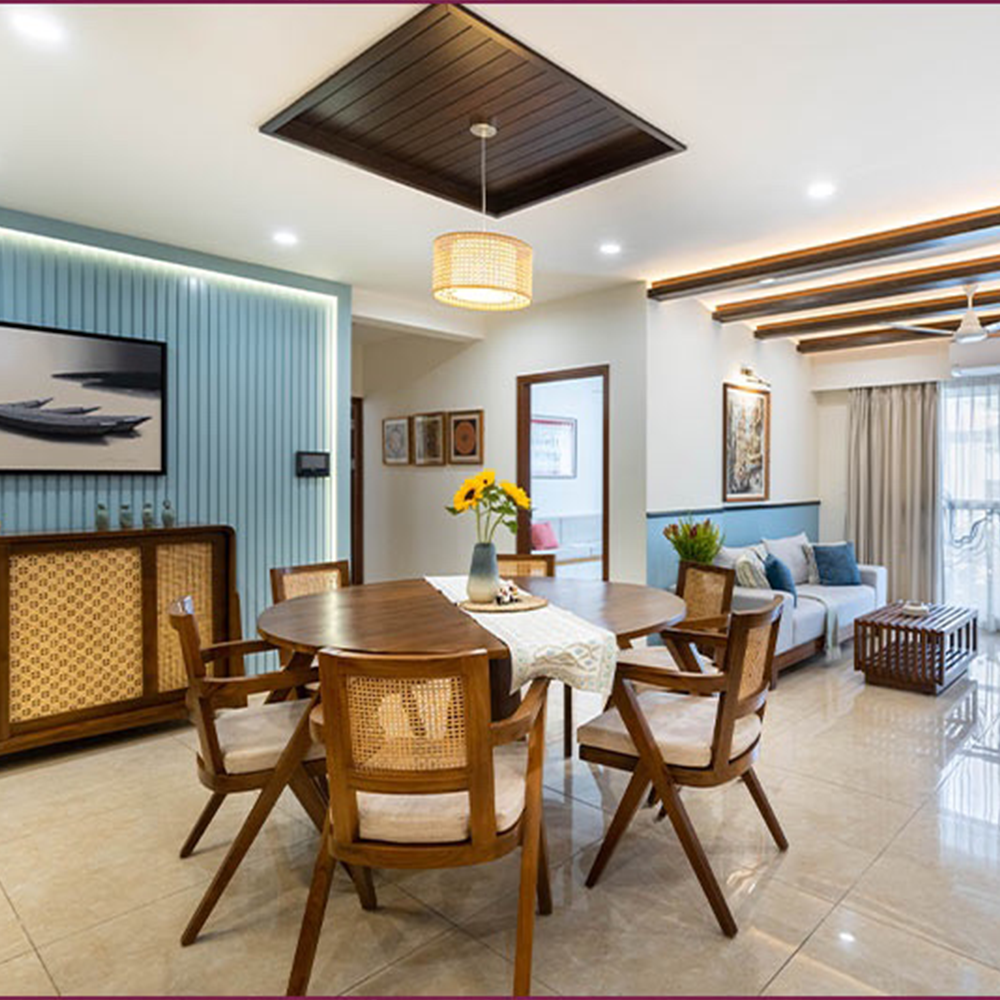
What is Rustic Interior Design?
Ever scrolled through Pinterest or Architectural Digest and thought, “How do I get that cozy, earthy feel without, you know, living in the countryside?” The answer is rustic interior design. More than just a trend, it’s a philosophy, a way of creating spaces that feel connected to nature, history and a slower pace of life. It’s all about bringing the grounded, genuine energy of the outdoors inside, with a focus on raw materials, rich textures and a vibe so warm…it’s basically a hug for your house.
While the classic rustic look often conjures images of heavy, dark woods and a purely traditional aesthetic, the real magic today lies in its evolution: modern rustic interior design. This style is the perfect glow-up, taking the soul of rustic design and blending it with the clean lines, open layouts and minimalist feel of contemporary living. It’s less “grandma’s dusty old chest” and more “chic sustainable sanctuary” that feels both current and timeless.
The Core Elements:
As a design enthusiast, I’ve found that the secret to a stunning rustic space lies in a few key principles. These are the building blocks we use to craft a home that is both beautiful and deeply personal.
1. The Materiality of Authenticity: No Fakes Here
This is the main character of rustic design. We don’t just use materials; we celebrate them in their most genuine state. This means prioritizing reclaimed wood with its unique imperfections, exposed brick that tells a story and natural stone that grounds a space. Every knot in the wood, every crack in the clay and every vein in the stone adds a layer of character that mass-produced materials can’t replicate.
Restoration Tip: Look for vintage furniture or wooden décor with character. Sand, polish, or lightly re-stain it to restore its beauty while keeping its history intact.
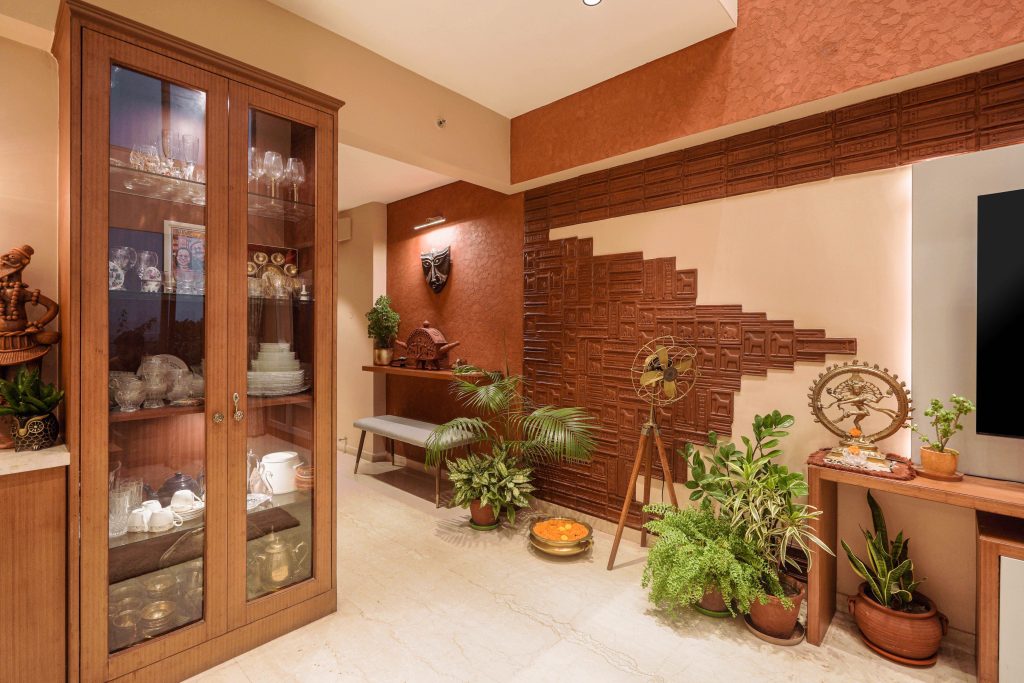
For a duplex apartment, we wanted to create an entryway that instantly communicated warmth and cultural depth. We used a richly textured, reddish-brown terracotta-inspired finish on the walls.We sourced the terracotta from local artisans in Bishnupur, Bengal. The highlight is a custom-designed wall panel featuring repetitive, handcrafted motifs reminiscent of temple architecture or ancient wood carvings. This piece acts as the primary rustic anchor. We used the existing marble flooring and paired it with abundant greenery and simple clay pots. A sleek, modern curio cabinet in solid wood provides both storage and a display for traditional artifacts, beautifully marrying the rustic feel of the earthen wall with the clean functionality of modern furniture. This entire corner shows how the raw, earthy textures (terracotta and clay) provide the authentic soul, while the lighting and the smooth cabinet keep the look polished and traditional.
2. The Palette of Earth: Earthy Colors that Calm the Soul
The color palette of a rustic home is a direct conversation with nature. We build a foundation with a neutral base of whites, beiges and soft greys. Then we layer in warmer more vibrant tones like terracotta, warm browns and deep greens. This palette isn’t about making a bold statement; it’s about creating a tranquil, calming atmosphere that feels like a retreat from the world.
Restoration Tip: If walls or furniture have faded over time, consider gentle restoration—like a soft wash, polish, or repaint in muted earthy tones—to keep the rustic feel without losing authenticity.

Often, the floor itself provides the richest color and character. Consider the impact of traditional patterned cement or clay tiles…their aged patina and deep, earthy hues of terracotta red, ochre and moss green instantly set a warm, heritage-rich color foundation that is inherently rustic.
3. The Art of Texture: A Sensory Feast
This is what gives a rustic space its soul and its comforting, lived-in feel. We love to mix and match different textures to create visual and tactile interest. Think about the contrast between a smooth, polished concrete floor and a shaggy wool rug or the difference between a sleek metal lamp and a woven rattan chair.
We did this project for our client with a focus on rustic elegance. The exposed brick wall became the highlight of the dining area, paired with warm wooden furniture and a touch of vintage charm. Subtle lighting, handcrafted details, and natural accents complete the look, creating a cozy yet refined space that feels both timeless and welcoming.
We have done this in our office which goes with our office aesthetics blending perfectly with the traditional rustic touch. This wall has brick paired with beautiful tiles in the middle. It gives a rustic touch to the overall office space.
What Sets Rustic Interiors Apart from Other Styles
Unlike minimalist or industrial design, which often prioritize clean lines and a streamlined look, rustic interiors embrace and celebrate imperfections. A worn wooden floor, a chipped stone countertop or a slightly distressed leather armchair isn’t a flaw…it’s a sign of character and history. This sets rustic design apart from styles that strive for polished perfection. It’s about finding beauty in the raw, natural state of things creating a space that feels grounded and genuinely lived-in rather than sterile and untouchable.

For this prestigious project, we executed a holistic Modern Rustic vision that allowed us to celebrate raw texture while integrating the client’s eclectic taste. We ensured the rustic aesthetic was expressed differently across two key areas:
The Main Living Room (Sophisticated Rustic): We established the rustic base with a white stacked stone wall, providing an immediate, high-impact natural texture. This rugged background was paired with a sophisticated tufted sofa for comfort. The industrial-rustic blend was achieved via the distressed, patinated metal coffee table and the lamp bases with exposed mechanical details. The final touch…vibrant, highly curated artwork and eclectic pottery injects personality, demonstrating that rustic design can be both cozy and chic.
The Seating Nook (Boho-Rustic Fusion): Here, the rustic element is more primal and immediate. The centerpiece is the massive, raw-cut wooden block used as a coffee table; its heavy, unfinished texture grounds the entire space and celebrates the wood in its most authentic form. We layered this raw base with delicate contrast: an antique-inspired settee with natural, patterned fabric, highly textured cushions, and simple clay pots holding live plants. This fusion of rugged wood, soft textiles and artistic prints creates a unique, balanced, Boho-Rustic ambiance that celebrates imperfection and tells a story in every detail.
This project beautifully captures the essence of rustic interior design where warmth, texture and authenticity define the space.
The highlight here is the exposed red brick wall, left in its natural, unpainted state to showcase the irregular tones, rough surface and handcrafted charm. Unlike polished modern finishes, rustic design embraces such imperfections as character.
The deep teal curved sofa adds a rich, earthy contrast to the brick’s warm undertone while the wooden bar unit with illuminated niches on the side introduces both function and warmth. Together, they create a setting that feels inviting and grounded, not staged or synthetic.
Where contemporary interiors chase sleek lines and gloss, rustic design like this stands apart through its honesty celebrating raw finishes, rich materials and emotional warmth. It’s not about looking perfect but about feeling real.
Achieving the Look Yourself
You don’t need a complete overhaul to introduce rustic charm into your home. Here’s how you can get started:
- Add Natural Materials: Swap out a synthetic rug for a natural jute one or bring in a small piece of furniture with a raw wood finish, like a side table or a bookshelf.
- Layer with Textures: Drape a chunky knit throw over your sofa or add linen curtains to soften a room. Pillows in different textures like wool and cotton can also make a big impact.
- Embrace Earthy Colors: Introduce warmth with throw pillows, a new piece of art or a small area rug in colors like terracotta, olive or ochre.
- Find Unique Pieces: Look for handcrafted pottery, a vintage mirror or an antique wooden bowl at local markets or online. These unique finds will instantly add a personal touch.
Restoration Tip: Even small items like a distressed picture frame or a vintage vase can be lightly restored to blend seamlessly into your rustic decor.
Sure, these little tweaks can totally give you that cozy, rustic vibe. But let’s be real…sometimes the dream is bigger than just swapping a few cushions or adding some wood accents. Mixing styles, hunting down the right materials and making everything flow together? That can get tricky. You could DIY it but if you’d rather skip the stress, you already know who to call!
Case Study: Rustic Kitchens – Hiraya Design Studio
Location: Kundapur, Karnataka
Designer: Apeksha Naik, Hiraya Design Studio
Source: AD India
The kitchen doffs its hat to Mangalorean homes of yore, with lime plaster walls, terracotta lights and a gabled ceiling. Recessed niches add a modern flourish.
Design Story:
This project highlights how rustic design can make functional spaces like kitchens feel warm and timeless. With lime-plaster walls, terracotta light fixtures and Athangudi tiles, the design reflects a deep connection to South Indian vernacular.
Rustic Highlights:
⦁ Lime plaster for natural texture.
⦁ Terracotta and handmade lights.
⦁ Traditional patterned tiles.
Takeaway: Rustic design can transform utility spaces into soulful corners, adding character to everyday life.
Case Study: Rustic Kitchens – Hiraya Design Studio
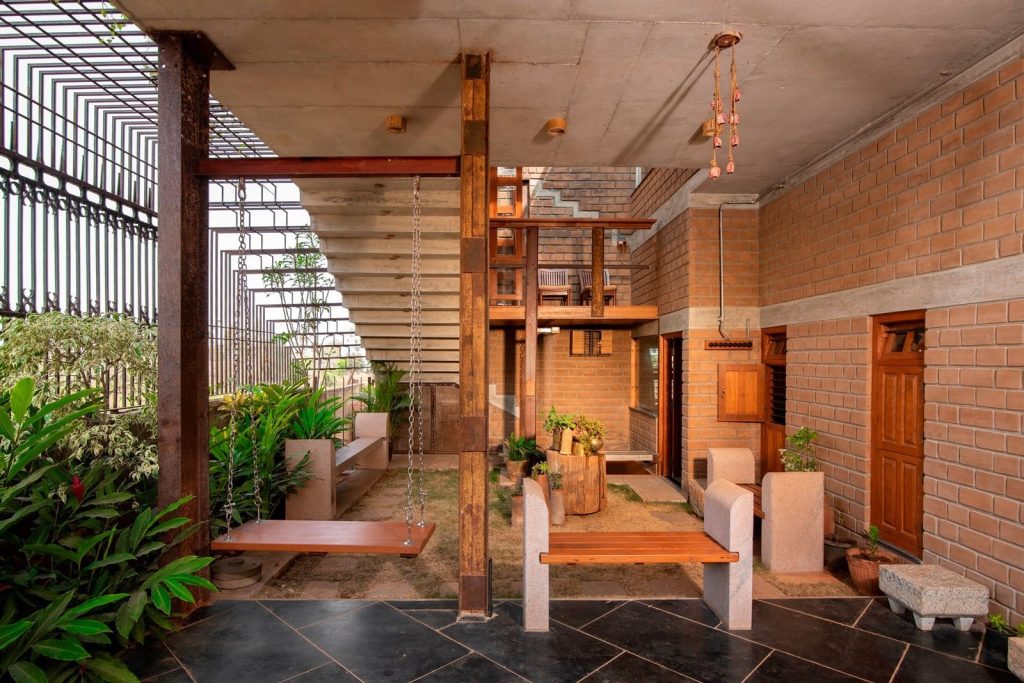
Location: Bengaluru
Designer: NNAD Studio (Nayanika Natesh)
Source: AD India
Design Story:
This home uses exposed brick walls as its soul. Combined with refurbished furniture, greenery-filled courtyards and large verandas, the house balances rustic charm with modern open layouts.
Rustic Highlights:
⦁ Exposed brick masonry as a primary finish.
⦁ Locally sourced wood and refurbished furniture.
⦁ Connection to gardens and outdoor nooks.
Takeaway: Rustic can be sustainable and stylish, especially when paired with reclaimed and natural materials.
Case Study: The Rustic Nook – Studio HC
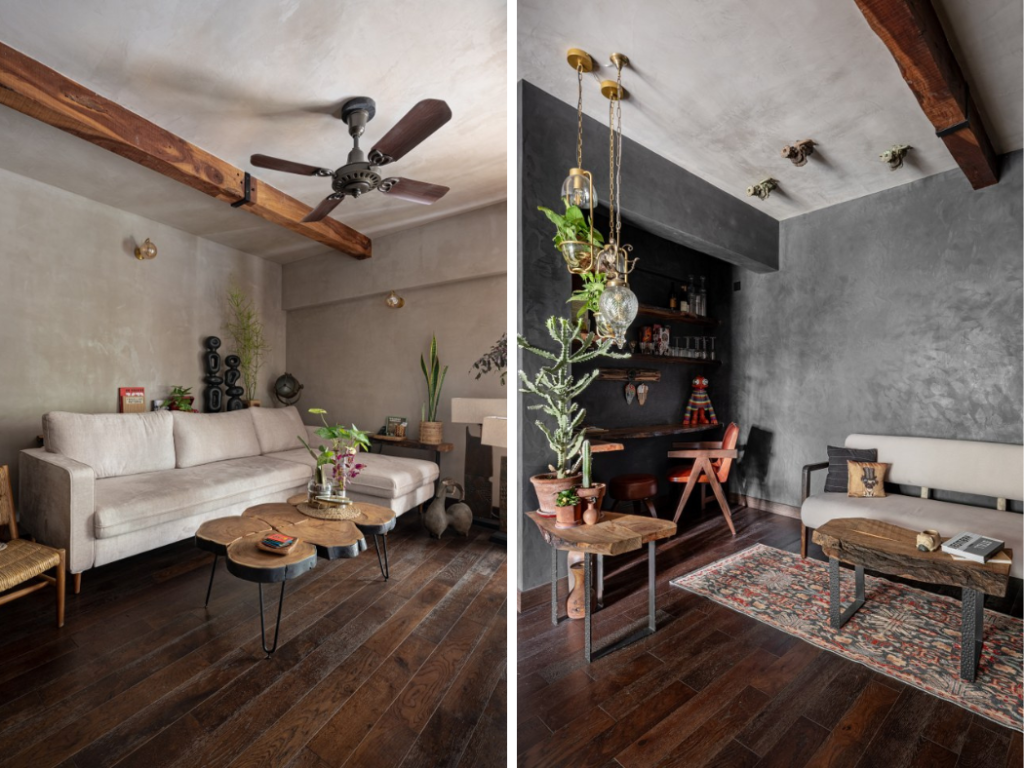
Design Story:
This city apartment was redesigned into a tranquil rustic retreat. Raw wood, stone-textured cladding, earthy color palettes, and handcrafted décor transform a compact space into a soulful home.
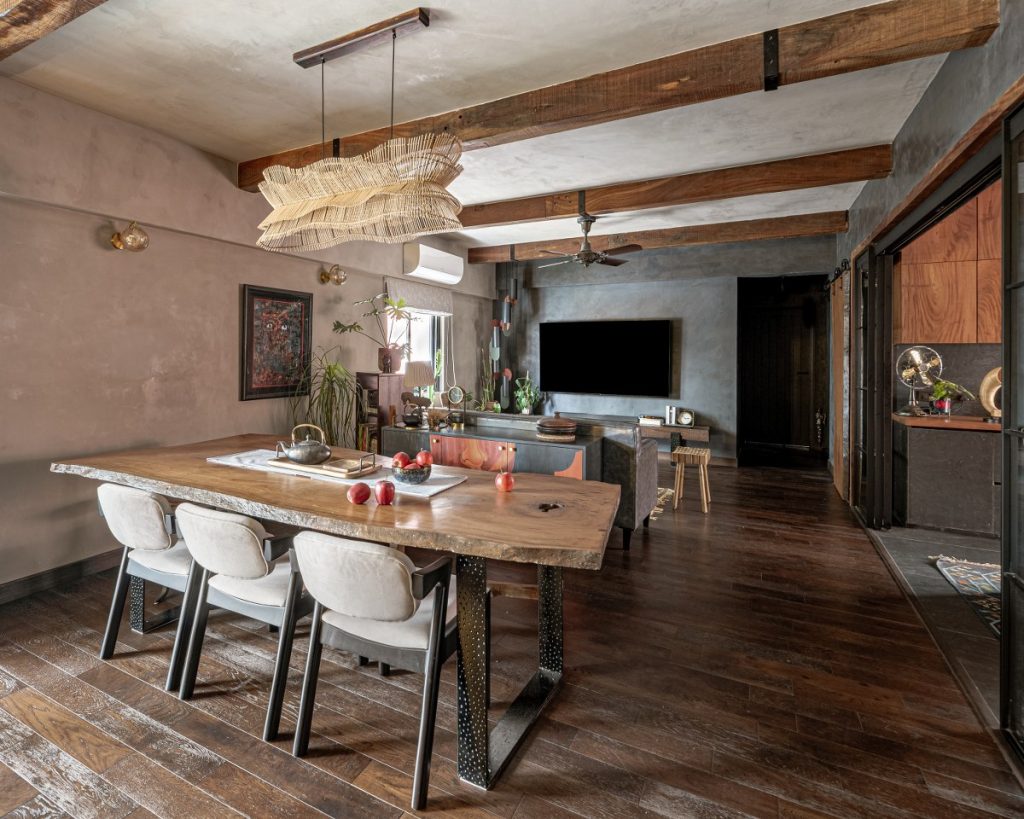
Rustic Highlights:
⦁ Earth-tone walls and muted furnishings.
⦁ Use of raw wood + stone finishes.
⦁ Handcrafted accents for authenticity.
Takeaway: Rustic is not limited to villas or farmhouses — it can transform apartments into cozy, nature-inspired escapes.
Indian Regional Rustic Influences: A Journey Through Design
Rustic design in India isn’t just a look… it’s a whole vibe. Every state has its own story, told through materials, colors and crafts. When these stories show up in homes, the space starts to feel like the place itself. At CeeBee Design Studio, exploring rustic design is like hopping across India, picking up inspo from one region, remixing it with modern comfort and making it your own.
The journey begins in Rajasthan, where the desert’s raw beauty shapes interiors. Carved wooden doors, jaali screens and solid sheesham furniture set a royal vibe. Ochre and terracotta walls echo the dunes, while pops of deep indigo or crimson keep things spicy.
Pro tip: Pair bold traditional pieces with chill modern furniture so it doesn’t feel like a museum.
Next stop: Goa…beachy, breezy and totally laid-back. Whitewashed walls, distressed wood and airy verandas give all the vacation feels. Portuguese tiles add color pops, wicker chairs bring chill vibes and the whole place just breathes.
Pro tip: Use patterned tiles as accents, not full floors…you want pops, not chaos.
Traveling east to Bengal, nostalgia hits hard. Terracotta tiles, red brick, cane furniture, woven cottons…it’s all warm and lived-in. Wooden four-poster beds, brass utensils and Kalighat art make it personal. Bonus inspo: Bishnupur terracotta- perfect for wall panels or earthy décor.
Pro tip: Terracotta accents add that rustic texture without making the room feel heavy.
“Down south in Chettinad, rustic goes luxe. Antique teak panels, old Athangudi tiles and intricately carved doors are not just preserved, they are carefully restored, sometimes refinished and thoughtfully integrated with modern interiors. This approach keeps heritage alive while maintaining contemporary functionality. Spacious courtyards, teak carvings, Athangudi tiles and intricate wood panels come together to create a luxurious, heritage-rich aesthetic.
Pro tip: Pair colorful Chettinad tiles with neutral walls so the vibe stays luxe, not loud.”
In Bangalore & Karnataka, rustic meets city chill. Exposed brick walls, rosewood furniture, greenery on balconies plus pops of Bidriware or Channapatna lacquer.
Pro tip: A few handcrafted statement pieces go a long way…no clutter needed.
Finally, Gujarat turns rustic into a festival. Mirror work, embroidered textiles, mud-plastered wall and painted furniture make spaces pop. Bold, vibrant and full of life.
Pro tip: Balance it out with neutral furniture or walls so the room doesn’t go overboard.
From Rajasthan to Bishnupur, Chettinad to Gujarat, each region has its own rhythm, textures and colors. Mix a carved door here, a tiled nook there and you’ve got a home that’s both cultural and modern. Heritage meets chill contemporary vibes…that’s when rustic design really hits different.
Expert View: The Timeless Appeal of Rustic Design
From my perspective, rustic design is more than just a passing trend. It’s a style that offers incredible longevity and a practical approach to home design. In an era of mass production, it champions craftsmanship and individuality. It’s also incredibly durable and low-maintenance, as the materials are naturally resistant to wear and tear. A scratch on a wooden table or a chip in a stone floor simply adds to its story.
Furthermore, the style’s focus on natural materials has a grounding effect on our well-being. It promotes a sense of calm and connection in our homes, which is something we all crave in today’s fast-paced world.
Conclusion: Crafting Your Perfect Rustic-Modern Space
Whether you live in a sprawling home or a compact apartment, the principles of rustic interior design can transform your space into a personal sanctuary. It’s a style that asks you to slow down, appreciate the natural world and tell your unique story through your home.
Ready to bring the timeless appeal of rustic design into your home? Don’t let the details overwhelm you. Let Cee Bee Design Studio craft your perfect space, blending modern functionality with a rustic heart.
Start small: revive one cherished piece, restore an old tile or repair a vintage chair. These touches bring history, character and soul to your home completing the perfect rustic-modern look.
FAQs: Your Rustic Design Questions, Answered
Q: What are some innovative ways to use lighting to enhance the modern rustic aesthetic, beyond just warm bulbs?
- Beyond the obvious choice of warm, soft lighting, we use light as a design element. Consider architectural lighting that subtly highlights the texture of an exposed brick wall or a reclaimed wood feature. We also love using unique fixtures…think woven rattan pendants over a dining table or floor lamps with a minimalist metal base and a linen shade. Dimmers are a must to give you control over the mood, allowing you to transition from a bright, active space to a cozy, evening retreat.
Q: I love different design styles. How can I successfully blend modern rustic with my love for, say, Scandinavian or industrial aesthetics without the space feeling visually chaotic?
- A: This is where the magic happens! The key is a consistent material or color palette. For a Scandinavian-rustic look, focus on light woods and a neutral palette, adding in rustic textures like sheepskin and woven wool. For an industrial-rustic vibe, use a consistent metal finish (like matte black or aged bronze) across your light fixtures and furniture legs and pair it with raw wood and exposed brick. The secret is to use one style as the dominant base and the other as an accent.
Q: My home has a mix of wood types. How do I make them work together in a rustic design without creating a jarring, mismatched look?
- This is a common challenge. Instead of trying to match them perfectly, embrace the diversity. Use a unifying element, like a consistent wall color (think a warm off-white) or a single type of metal hardware throughout the space. You can also place the different wood tones in different zones, for example, a dark teak coffee table in the living room and a lighter mango wood dining table. The different woods then become complementary pieces, each adding to the unique character of the home.
Q: I have a small apartment with limited access to natural light. How can I still achieve a modern rustic feel without making the space feel dark and cramped
- This is a fantastic question and a solvable design challenge. Focus on a light-toned color palette on your walls and floors. Choose lighter woods like pine or ash and pair them with sheer, linen curtains to maximize whatever light you do have. Large, strategically placed mirrors with simple, rustic frames can work wonders by reflecting light and making the space feel bigger. The focus shifts from “dark and moody” to “bright and airy rustic.
Q: What are some creative, non-traditional ways to incorporate natural materials that go beyond just wood and stone?
- Let’s get creative! Consider using materials like terracotta for planters or even a backsplash. A partition wall made of bamboo or cane can add texture and define a space. For textiles, explore undyed wool, raw silk or linen. Even small details like using a large, naturally formed rock as a doorstop or placing a bowl of river stones on a coffee table can make a big impact.
Q: What’s the best way to handle a small entryway in a rustic style?
- A small entryway can be a great place to introduce the style. Use a simple wooden bench for seating, a small jute rug and a wall-mounted coat rack made of reclaimed wood or metal pipes. This provides functionality while setting a rustic tone for the rest of the home.
Q: I’m concerned about maintenance. Are there specific rustic materials that are durable and easy to clean, especially for a family with kids or pets?
- Yes, durability is key. For flooring, natural stone or treated concrete are excellent choices as they are hard-wearing and easy to wipe clean. For furniture, a distressed leather sofa ages beautifully and is remarkably resilient to spills and scratches. Reclaimed wood is also a great option, as its pre-existing imperfections mean you don’t have to worry about new marks. Look for furniture with simple, clean lines that are easy to dust and maintain.
Q: How do I ensure my home doesn’t look like a rustic-themed restaurant or a resort? What’s the secret to making it feel personal and residential?
- The key is to avoid over-the-top, thematic decor. A home should feel personal, not like a stage set. Focus on one or two statement rustic pieces and let them breathe. Mix in modern pieces that reflect your personality, whether it’s a sleek TV unit, a modern piece of art or a collection of books. The goal is to blend the rustic elements into a cohesive, comfortable home that tells your unique story, not to replicate a commercial space.
Q: How do I ensure my rustic furniture is also comfortable?
- It’s all about balance. A rustic wooden chair might not be comfortable on its own but you can add a soft cushion or a sheepskin throw to it. Choose a sofa with deep, plush seats and cozy cushions. The goal is a look that’s rustic in aesthetic but modern in comfort.
Q: I’m a tech-savvy person. How can I seamlessly integrate smart-home technology into a design that celebrates the raw and natural?
- This is where modern rustic truly shines. We can conceal smart speakers in woven baskets or in custom-made wooden enclosures. Smart lighting can be controlled via an app and the dimmers can create the perfect cozy ambiance without a single switch visible. For wiring and cords, we use clever storage solutions to keep them hidden from view. The technology should work for the home, not define it.
Q: How do I handle furniture selection? Should I go for bespoke pieces or can I find items off-the-shelf that fit the style?
- A mix of both is ideal. Custom-made or bespoke pieces are great for statement items like a dining table or a console because they can be tailored to your space and reflect a specific aesthetic. However, you can absolutely find many great options off-the-shelf. Look for pieces made from solid wood with a visible grain or sofas with linen or leather upholstery. The trick is to have a keen eye for materials and texture, even in ready-made furniture.
Q: How do I ensure my home feels like a cohesive rustic design, rather than a collection of random “earthy” pieces?
- The secret is a cohesive color and material palette. Before you buy anything, decide on your primary colors and the main material you want to feature. For example, you might decide on a palette of whites and browns, with reclaimed wood as your main material. Then, every piece you choose, from a cushion to a side table, should fit within this palette to ensure a unified and intentional look.
Speak to us:
Follow us on:
About us
Welcome to CeeBeeDesignStudio, an Indian homegrown interior design brand where every home is a canvas and every design is a story.
We’ve proudly completed over 1000 residential and 400 commercial projects across 7 cities, earning a reputation for unmatched aesthetic acumen and client satisfaction. Our studio has also been recognized with multiple national awards, a reflection of our commitment to excellence, storytelling, and design innovation.
From thoughtfully styling modern apartments to restoring heritage homes, we bring soul, sustainability, and structure into every project.
Enter Your Details
About Us
CeeBeeDesignStudio is one of the fastest growing interior execution companies. Currently we have very strong presence in Bangalore, Goa, and Kolkata. Our motto is to keep the clients requirement and budget in mind and give a qualitative result on time.
Quick Link
Contact Info
- Door No-18, 3rd B Cross, Domlur II Stage, Bangalore 560071
- +91 8697306015
- chitralekha@ceebeedesignstudio.com
Contact Info
- 3045 Rajdanga main road, Kolkata, West Bengal 700107
- +91 8697306015
- chitralekha@ceebeedesignstudio.com
- Copyrigt © 2025 CeeBeeDesignStudio Pvt. Ltd

